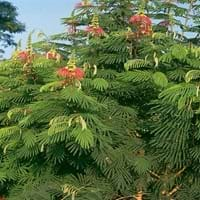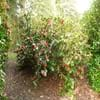Life Span
Perennial
Perennial
Origin
South America
Russia/Siberia, China
Types
Not available
Dwarf Siberian Peashrub, Sutherland Peashrub, Weeping Siberian Peashrub
Habitat
Subtropical climates, Tropical areas, Tropical Climate
Forest edges, gully slopes, Open Forest, Riverbanks, Sandy areas
USDA Hardiness Zone
9-12
2-8
Sunset Zone
H1, H2, 22, 23, 24
A1, A2, A3, 1a, 1b, 2a, 2b, 3a, 3b, 4, 5, 6, 7, 8, 9, 10, 12
Habit
Spreading
Narrow Upright/Fastigiate
Flower Color
Red, Magenta
Yellow
Flower Color Modifier
Not Available
Not Available
Fruit Color
Not Available
Brown
Leaf Color in Spring
Green, Light Green, Pink, Copper
Light Green
Leaf Color in Summer
Green, Light Green
Light Green
Leaf Color in Fall
Green
Light Green, Light Yellow
Leaf Color in Winter
Green
Not Available
Leaf Shape
bipinnate
Pinnate
Plant Season
Spring, Winter
Spring
Sunlight
Full Sun, Partial Sun
Full Sun
Growth Rate
Very Fast
Fast
Type of Soil
Loam, Sand
Clay, Loam
The pH of Soil
Acidic, Neutral
Acidic, Neutral, Alkaline
Soil Drainage
Well drained
Well drained
Bloom Time
Early Spring, Spring, Late Spring, Late Fall, Early Winter, Winter, Late Winter
Spring
Tolerances
Drought
Drought, Salt
Where to Plant?
Ground
Ground
How to Plant?
Seedlings
Cuttings, Layering, Seedlings
Plant Maintenance
Medium
Low
Watering Requirements
Average Water Needs
Keep the ground moist but not water-logged, occasional watering once established
In Summer
Lots of watering
Moderate
In Spring
Moderate
Ample Water
In Winter
Average Water
Average Water
Soil pH
Acidic, Neutral
Acidic, Neutral, Alkaline
Soil Type
Loam, Sand
Clay, Loam
Soil Drainage Capacity
Well drained
Well drained
Sun Exposure
Full Sun, Partial Sun
Full Sun
Pruning
Remove damaged leaves, Remove dead branches, Remove dead leaves
Remove dead branches, Remove dead or diseased plant parts
Fertilizers
All-Purpose Liquid Fertilizer
fertilize in spring
Pests and Diseases
Fungal Diseases, Scale insects
blister beetles, Septoria leaf spot, stem decay
Plant Tolerance
Drought
Drought, Salt
Flower Petal Number
Not Available
Single
Foliage Texture
Fine
Fine
Foliage Sheen
Matte
Matte
Attracts
Butterflies
Bees, Hummingbirds
Allergy
no allergic reactions
Diarrhea, Vomiting
Aesthetic Uses
Not Used For Aesthetic Purpose
Not Used For Aesthetic Purpose
Beauty Benefits
Not Available
used as a dye
Environmental Uses
Air purification
Erosion control, Fixes Nitrogen, Food for animals, Shelter for wildlife, Windbreak
Medicinal Uses
Homeopathy
Cancer, Dysmenorrhea, Gynaecological
Part of Plant Used
Flowers, Wood
Leaves, Seeds
Other Uses
Animal Feed, Used as firewood
Fibre, For making oil, Shelterbelt, Used as a dye, Used for making informal hedge
Used As Indoor Plant
No
No
Used As Outdoor Plant
Yes
Yes
Garden Design
Feature Plant, Mixed Border, Screening, Wind Break, Tropical
Hedges, Mixed Border, Screening, Wind Break
Botanical Name
Calliandra calothyrsus
CARAGANA arborescens
Common Name
powder-puff, powder puff plant, fairy duster
Siberian peashrub, Siberian pea-tree, caragana
In Hindi
Calliandra calothyrsus
Siberian peashrub
In German
Calliandra calothyrsus
Gemeiner Erbsenstrauch
In French
Calliandra calothyrsus
Caraganier de Sibérie
In Spanish
Calliandra calothyrsus
Siberian Peashrub
In Greek
Calliandra calothyrsus
Siberian Peashrub
In Portuguese
Calliandra calothyrsus
Siberian peashrub
In Polish
Calliandra calothyrsus
Karagana syberyjska
In Latin
Calliandra calothyrsus
Siberian Peashrub
Phylum
Tracheophyta
Magnoliophyta
Class
Magnoliopsida
Magnoliopsida
Genus
Calliandra
Caragana
Clade
Angiosperms, Eudicots, Rosids
Angiosperms, Eudicots, Rosids
Tribe
Ingeae
Not Available
Subfamily
Mimosoideae
Not Available
Number of Species
Not Available
Season and Care of Powder Puff Tree and Siberian Peashrub
Season and care of Powder Puff Tree and Siberian Peashrub is important to know. While considering everything about Powder Puff Tree and Siberian Peashrub Care, growing season is an essential factor. Powder Puff Tree season is Spring and Winter and Siberian Peashrub season is Spring and Winter. The type of soil for Powder Puff Tree is Loam, Sand and for Siberian Peashrub is Clay, Loam while the PH of soil for Powder Puff Tree is Acidic, Neutral and for Siberian Peashrub is Acidic, Neutral, Alkaline.
Powder Puff Tree and Siberian Peashrub Physical Information
Powder Puff Tree and Siberian Peashrub physical information is very important for comparison. Powder Puff Tree height is 180.00 cm and width 240.00 cm whereas Siberian Peashrub height is 460.00 cm and width 300.00 cm. The color specification of Powder Puff Tree and Siberian Peashrub are as follows:
Powder Puff Tree flower color: Red and Magenta
Powder Puff Tree leaf color: Green, Light Green, Pink and Copper
Siberian Peashrub flower color: Yellow
- Siberian Peashrub leaf color: Light Green
Care of Powder Puff Tree and Siberian Peashrub
Care of Powder Puff Tree and Siberian Peashrub include pruning, fertilizers, watering etc. Powder Puff Tree pruning is done Remove damaged leaves, Remove dead branches and Remove dead leaves and Siberian Peashrub pruning is done Remove dead branches and Remove dead or diseased plant parts. In summer Powder Puff Tree needs Lots of watering and in winter, it needs Average Water. Whereas, in summer Siberian Peashrub needs Moderate and in winter, it needs Average Water.





